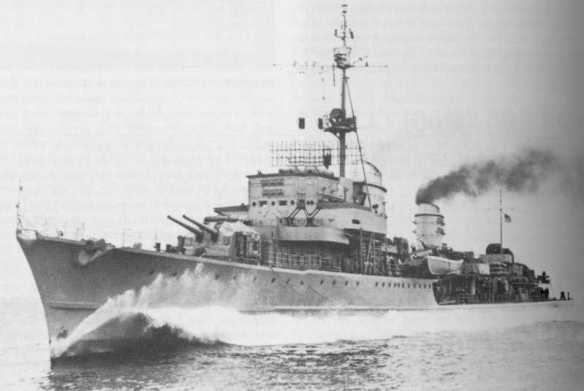Zerstörer 1936A
DKM Z-39 (Destroyer) (1945)
In addition to the destroyer production of those naval powers that represented the victors of World War I, the period between 1935 and September 1939 saw the return of two former maritime forces. The first of these, and the cause of much anxiety among other nations, was Germany. In May 1935, Hitler repudiated the Treaty of Versailles in keeping with his goal to once again make Germany a world power. This course was given legitimacy by Great Britain. Rather than enforce Versailles, in June 1935, as part of its policy of appeasement to avoid war, the British openly violated the treaty by signing a naval pact that allowed for a German fleet that was 35 percent the size of the Royal Navy. Both of these actions ultimately counted for little, because by May 1935 construction was already well under way on new destroyers that violated the peace agreement.
The first class of German destroyer built since World War I was the 1934 class that served as the blueprint of all subsequent destroyer construction for Nazi Germany. Four of these ships were launched in 1935, and each measured 391 feet, 5 inches by 37 feet by 13 feet, 1 inch, with a displacement of 1,625 tons. Unlike the German craft of the World War I era, these ships mounted a larger gun armament. A unit of the 1934 class mounted five 5-inch guns in single mounts protected by gun shields. Two each were sited on the bow and stern while the fifth was located aft amidships. The vessel also carried eight 21-inch torpedo tubes, and an assortment of AA guns. Like all subsequent destroyer types and many of those in the past, 1934-class vessels were designed to ship mines if necessary.
One drawback of this class that extended to later designs was its engines. German engineers incorporated a new high-pressure steam propulsion plant that was intended to produce greater power output. This machinery was designed to yield a maximum speed of 38.2 knots, but such velocity was rarely attained, and the plant was subject to frequent breakdowns. An additional negative aspect was the fact that these ships were rather unstable in a seaway. As a result, Germany was not the successful destroyer producer that it had been in the years before World War I. These problems were duplicated in an improved 1934 class of 12 ships that were launched between 1936 and 1937. The following class, however, was an improvement.
Although the six 1936-class ships retained the problematic high-pressure steam propulsion plant, they were designed with a new feature to help correct problems with seaworthiness. This was the clipper bow, a feature that marked some capital ships of the German Navy and had been tried by other powers. Clipper bows, named after fast sailing ships of the nineteenth century, were those where the sides of the bow flared out to better plow through the water and thereby help the ship maintain its speed in a seaway. These ships were consequently much better seafaring boats. The hull of one of these ships measured 404 feet, 2 inches by 38 feet, 8 inches by 13 feet, 1 inch and displaced 1,811 tons. Its armament and engines were virtually the same as the 1934 class, but the clipper bow enabled the possibility of a maximum 40 knots. By September 1939, the German Navy had made a relatively quick return to the family of destroyer powers. All of these vessels, which were originally known simply by their pennant numbers, were eventually named after famous German naval figures of World War I.
Germany’s wartime production paled in comparison to that of Japan and consisted only of conventional destroyers. Most German vessels built during the war were variations of the 1936 type. With 19 units in three classes, they were launched between December 1939 and January 1944. The vulnerability of German shipyards to Allied strategic bombing attacks and shortages of material in the latter years of the war prevented the launch of three additional classes. Construction began on 8 of the 13 projected ships, but none ever left their shipyards. One of these classes was a design for a behemoth that incorporated armor on a hull that was 554 feet, 5 inches long and displaced 6,300 tons. It would have been armed with six 5.1-inch guns in three dual mounts enclosed by gun houses as well as 10 21-inch torpedo tubes. The last German destroyer launched was the one-ship 1942 type that resembled its 1936 predecessor, but with heavier AA armament in keeping with the trend in all of the navies of the combatants. This vessel never entered service, being bombed soon after its launch. Despite the deterioration of Germany’s destroyer program, the fleet was enlarged further through vessels seized from countries occupied during the war. One modern Dutch destroyer and a Greek vessel were taken. A French destroyer was also procured, but it was under construction at the time and never completed.
